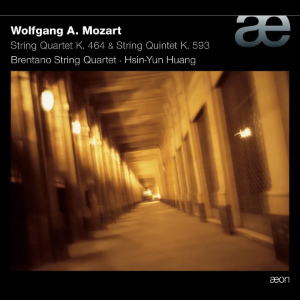
Wolfgang Amadeus Mozart (1756-1791)
String Quartet in A major K.464 (1785)
String Quintet in D major K.593 (1790)
Brentano String Quartet
Hsin-Yun Huang (viola, K.593)
rec. 2005, American Academy of Arts and Letters, New York City
Aeon AECD0747 [62]
The Brentano Quartet recently marked its tenth year as quartet in residence at the Yale School of Music. Its namesake, Antonie Brentano, is believed by scholars to be the “Immortal Beloved” of Beethoven’s famous unsent love letter. The quartet is probably best known as the ensemble whose playing of Beethoven’s Quartet in C sharp minor, op.131, we hear in the 2012 film A Late Quartet, in which Christopher Walken and Philip Seymour Hoffman, among others, appear as members of the (fictional) Fugue String Quartet. After Walken’s character tells his colleagues that he plans to retire, personal conflicts bubble up, and the quartet must struggle to hang together musically.
While the Tokyo String Quartet, whom the Brentanos succeeded at Yale, saw multiple reshufflings during their lengthy run, the Brentano Quartet has made just one change in personnel since forming at the Juilliard School in 1992. Following the 1998 departure of founding cellist Michael Kannen, the group has had the same four members —violinists Mark Steinberg and Serena Canin, violist Misha Amory, and cellist Nina Lee.
That continuity is unmistakable in the group’s playing. The Brentanos have an unfailing unity of intent across a broad range of compositions, as I had the pleasure of hearing at a concert of Haydn, Beethoven, and Shostakovich this past summer. This is not to say that they played these differing pieces the same way. Rather, while style and tone were thoughtfully tailored to each piece, the four musicians maintained a remarkably high degree of musical cohesion. Moreover, they made a beautifully balanced and blended sound, even when, as in the Russian’s somber —sometimes anguished— eighth quartet, the music is far from “pretty.”
From the first bars, these strengths are very much in evidence on this 2007 release from the French label Aeon. It pairs a quartet from Mozart’s set of six dedicated to Haydn, the A major K.464, with the composer’s penultimate work for string quintet, the D major K.593. For this specific coupling, this recording evidently has the field to itself. The quartet is the more ambitious composition of the two: it is both longer and more intricately worked out. In a letter to the dedicatee, Mozart commended the six quartets to him as his “children,” adding that they were “the fruit of a long and laborious endeavor.” The most distinctive feature of the A major is its expansive slow movement, marked andante, in the form of a theme with variations. An air of serenity pervades the work but never monotonously so, and passages of stronger emotion are interspersed throughout.
For me, the outstanding virtue of this performance is the Brentanos’ ability to bring out each movement’s myriad shifts in mood, however subtle, while never losing sight of the overall line. Their collective sound is of great beauty, as one expects for this composer. In a telling comparison, I listened to the Alban Berg Quartett’s 1978 recording (Warner Classics 2564 62335-2; review). While there is no questioning the ABQ’s technical prowess, their style is more matter of fact, even blunt at times, and dynamic contrasts can seem overdone. I find this approach simply not as persuasive as the Brentanos’ in chamber music of this period.
For the quintet in D major, the Brentanos are joined by violist Hsin-Yun Huang, an accomplished artist in her own right. Not as deep as, more outgoing and ebullient than the quartet, this work seems to be about giving five musicians a chance to enjoy themselves —though to be sure, the writing is still at a rarefied level. As in the quartet, the ensemble consistently finds the music’s expressive center, and here the resulting interpretation is both charming and engaging.
The recording, made at the Academy of Arts and Letters in New York City, captures the beauty of tone I heard in concert, as well as a nicely judged halo of hall sound. While the choice of two less renowned (though hardly obscure) Mozart chamber works might initially seem offbeat, this is exemplary Mozart playing, well worth hearing.
Doug Barnes
Previous review: Dominy Clements (June 2007)
Buying this recording via a link below generates revenue for MWI, which helps the site remain free




















